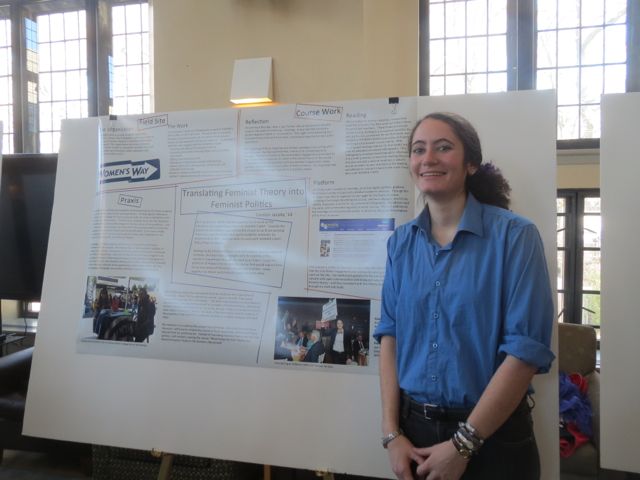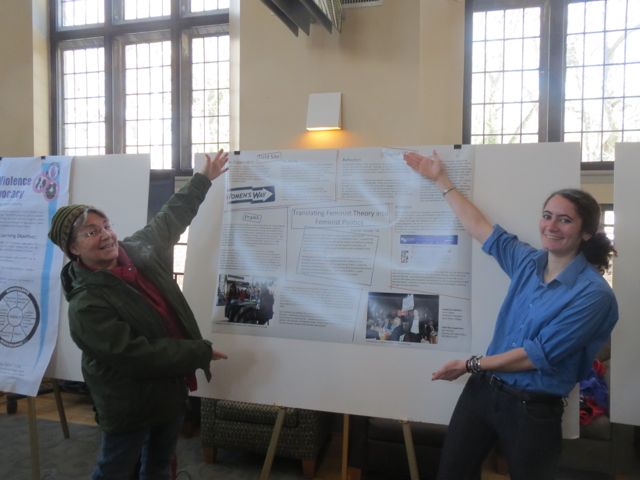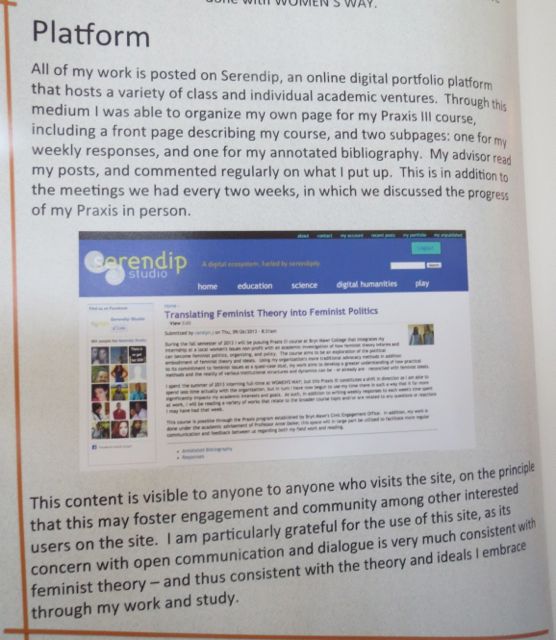Serendip is an independent site partnering with faculty at multiple colleges and universities around the world. Happy exploring!

Self Evaluation
I came to Feminist Critical Studies later than most, I had just recently dropped a class and decided to pick up this one. When looking at the course description I became overly excited at what this course might have in store. I had just recently been proclaiming myself as a black feminist, which is what I wrote my college essay about, and my junior and senior year and high school had been devoted to discussing black women and their representation in the media, so I thought that this course would take me even further in exploring this desire. Overall, I must say this course was a learning experience, but it was not at all what I expected. I thought that we might have been doing a little more discussing of feminist theory and studying in normative school/lecture structure the various waves of feminism. However, I am very glad that this class was not set up as a lecture, through discussions and group work I was able to get away from the mundane structure of most of my classes and hear more from the students than just the professor. Often my mother preaches that respect needs to be given in both directions, from youth and adults in power, and from this classroom structure I really felt mutual respect between all who were in the classroom. What helped this even more was the circle that we sat in, where everyone could acknowledge each other.

Does Power Feminism Exist? last web event
The definition of power feminism is the act of a woman amassing power in a male dominated capitalist society, and breaking through the gates that have historically held women back from powerful positions. These women inspire others that it is possible for them to reach power in this patriarchal system. But is power feminism real? Can the power of one individual woman liberate us all? Does the feminist agenda of this individual speak to the intersectional identities of others?
Author and feminist activist bell hooks believes that power feminism is not real, she states: “Power feminism is just another scam in which women get to play patriarchs and pretend that the power we seek and gain liberates us.” To further explore why she does not believe in power feminism I turn to hook’s critique of Facebook COO, Sheryl Sandberg. In Dig Deep: Beyond Lean In, hooks analyzes Sandberg’s book Lean In, and the advice she gives as a self-claimed feminist. Hooks makes three main critiques of Sandberg: she does not include or consider the perspectives and identities of women of color, she does not recognize the challenges of women in poverty, and she does not seek to challenge the white supremacist capitalist patriarchy.
Sandberg

Words in My Mouth, like Strawberries, in October
I played with Frost. It was October. If only I had learnt from Ray Bradbury that October was a grotesque Country where you should only step foot if you are looking to be assaulted by the skeletons your mind shoved in a closet on purpose in the first place. It was October, silly.
I opened the closet, and out walked Robert. He brushed off the Frost from his shoulders; it must have been cold and dusty behind the Doors. Or he was tired of being cold. He walked out. And I stepped into his Home Burial.
I fell deep. The door was wide open and I fell damn deep. I told myself all I had to do was pull apart the words and reconstruct them into a window. So I sat on the narrow, creaky staircase and listened attentively to Frost and his wife. But slowly – I found – slowly, I was listening to myself. And I had the same voice as his wife.
I was accusing. I was hurt. I was pushing away. I was losing. I was missing. Home Burial.
There wasn’t a way to pick out my own words, care about his, and try to assemble a window which might cast light on our conflict. What we needed to was to smash open the windows we already had, and get some fresh air.
I was overwhelmed as I fell deeper and deeper into Frost’s Home. Or was Frost just pulling out some things that already existed deep in the back of my closet?
Lay them on the table. Let me hear you say what you already know about them, but use a different voice so you can hear yourself do the talking.

Barnes Again
Many people view the Barnes Foundation in Philadelphia as a complete violation of a dead man’s will. After all, Albert C. Barnes would not have enjoyed the audio tours, easy accessibility, gift shop, website… The list would be endless. His sole intention for the Barnes was to educate and enlighten those using art, and he arranged every single inch of the space with his way of seeing: through an artist’s lens, with thought and purpose in every part of the wall.
I started looking at the paintings one by one; I wanted to see every single piece of art in the area, which is usually my attitude when I go into a museum or gallery. The museum contained works by some of my favorite artists: Manet, Seurat, Cézanne, Pissarro, and Renoir. I enjoyed looking up close at the paintings (not too close, obviously, as there were clear markers around the perimeter of each room) then seeing the painting as a whole. In a Renaissance painting, it’s easy to see how the strokes contribute to the overall work. In comparison, an Impressionist painting has short, choppy strokes. Out of context with a small close-up of the painting, you would not be able to tell what it is. However, once you look at it from afar, you could see how the strokes make a face, flower, or change the lighting. However, I noticed the furniture, and door locks on the wall. I wondered what their purpose was.

"The Intelligent Plant"
Hi Class!
Just read this interesting New Yorker article by Michael Pollan that follows a group of scientists who are seeking to prove that plants are a lot more like us than most people realize, capable of learning, memory, cognition and computation! I thought that this was incredibly relevant for the ecofeminist argument against specism. Skim through the article if you get a chance to take a break from finals week.
http://www.newyorker.com/reporting/2013/12/23/131223fa_fact_pollan

Self-Evaluation for Cat
When I began this class, I did so as a student who had already taken a course with Anne. I was a lot more prepared than I was at the beginning of my first class with her. In addition to being my first course with Anne, the ESEM that I took with her was my first college course. In contrast, I began Critical Feminist Studies after a year at Bryn Mawr, and that shows. I have a better grasp of both “college” (admittedly, mostly in the form of more questions and fewer answers than I began with when I matriculated at Bryn Mawr) and what “Bryn Mawr” is. Just by comparing the Serendip posts that I wrote last year with the ones that I shared this semester, there’s a noticeable distance. I’ve changed as a person over the last year—not a particularly extraordinary circumstance, but a true one. The ESEM program assumes that students are not quite up to the “Bryn Mawr standard” yet, mostly in terms of writing and classroom discussion, and, upon entering this course, I’m at the very least, a stronger writer and conversationalist than I was when I began that ESEM.








